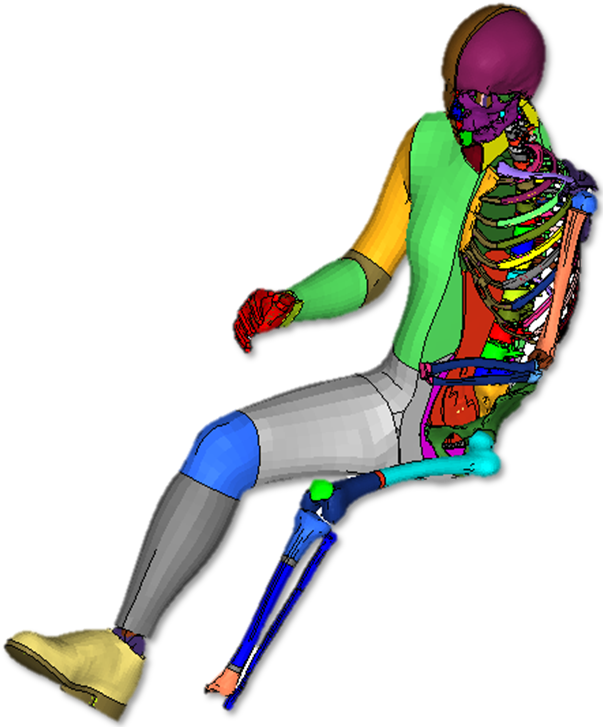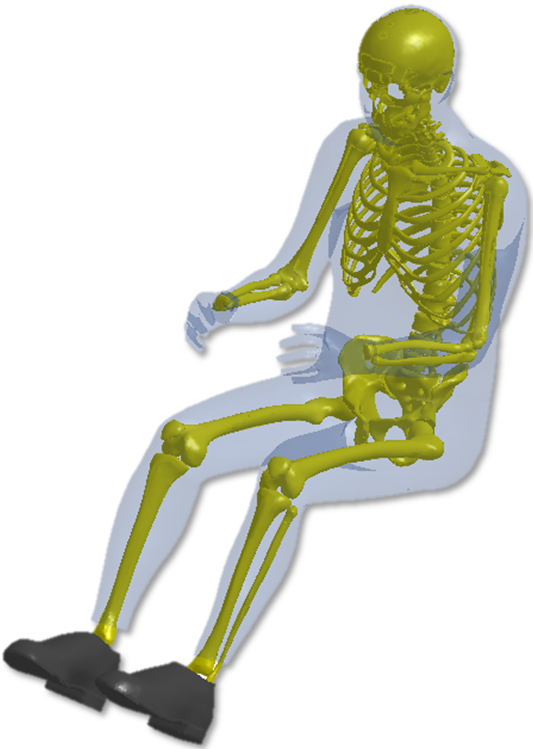
HERMES is an Efficient, Parametric, and Posable Finite Element Human Model Representing a Diverse Population
HERMES was developed based on statistical human geometry models and mesh morphing methods
HERMES was developed over several years by an experienced biomechanics research team at the University of Michigan Transportation Research Institute (UMTRI)
HERMES was developed to fill a need for a fast FE model to conduct the thousands of simulations needed to optimize protection systems for populations. Most FE models represent the same two or three sizes of people (the so-called 5th, 50th, and 95th percentile). But humans have a wide range of shapes and sizes, so accurately representing a population requires a parametric model that can rapidly generate geometry for any person.
HERMES is under continuous development, but we are sharing it publicly to encourage researchers to consider population diversity when designing protection systems. The non-commercial license allows for use in internal research and development only. Use in academic research is permitted. If you would like to use HERMES in a commercial application (that is, as part of a product or service for sale), please contact us.
Most importantly, please let us know how you are using the model and contact us with any problems or suggestions for improvements.
If you publish research using HERMES, please cite:
Hu J, Dhawan M, Fan X, and Reed MP (2022) Toward Improved Safety Equity: An Efficient, Parametric, and Posable Finite Element Human Model Representing a Diverse Population, IRCOBI Europe Conference. http://www.ircobi.org/wordpress/downloads/irc22/pdf-files/2237.pdf
ABOUT OUR MODELS
The following Figure shows the general methods for developing the parametric HERMES models. Statistical geometry models
of skeleton (skull, cervical spine, ribcage, lumbar spine, pelvis, femur and tibia) and external body surface are used to predict
the geometry for the target body dimensions based on age, sex, stature, body mass index (BMI), and sitting height to stature
ratio (SHS). Such statistical geometry models were developed in our laboratory over the past 10 years based on clinical CT
scans and volunteer body scans from hundreds of subjects through image segmentation, landmarking, mesh
morphing/mapping, Generalized Procrustes Alignment (GPA), Principal Component Analysis (PCA), and regression analysis.
Bony landmarks collected from the body scan data were used to integrate the skeleton into the body surface model, while
local mesh morphing was performed to correct potential bone-to-skin penetrations. A mesh morphing method links the
baseline HERMES mesh to the statistical geometry targets, so that the morphed models can represent individuals with a wide
range of body size and shape.
Method overview for developing parametric HERMES models

The following Table shows the subject sample size and associated publications for developing the statistical models of different bones and body shape. A brief introduction of HERMES development and validations can be found in this IRCOBI paper.
Statistical geometry models for HERMES
*Limited landmarks were used to develop the HERMES.
References
Brynskog E, Iraeus J, Reed MP, Davidsson J (2021) Predicting pelvis geometry using a morphometric model with overall anthropometric variables, Journal of Biomechanics, 126: 110633. DOI: 10.1016/j.jbiomech.2021.110633
Hu J, Dhawan M, Fan X, and Reed MP (2022) Toward Improved Safety Equity: An Efficient, Parametric, and Posable Finite Element Human Model Representing a Diverse Population, IRCOBI Europe Conference.
http://www.ircobi.org/wordpress/downloads/irc22/pdf-files/2237.pdf
Klein KF, Hu J, Reed MP, Hoff CN, Rupp JD (2015) Development and Validation of Statistical Models of Femur Geometry for Use with Parametric Finite Element Models, Annals of Biomedical Engineering, 43(10): 2503-2514. DOI: 10.1007/s10439-015-1307-6
Klein, KF (2015) Use of Parametric Finite Element Models to Investigate Effects of Occupant Characteristics on Lower-Extremity Injuries in Frontal Crashes, PhD dissertation, University of Michigan.
https://deepblue.lib.umich.edu/handle/2027.42/113339
Park BK, Jones MLH, Ebert S, Reed MP (2021) A parametric modeling of adult body shape in a supported seated posture including effects of age, Ergonomics, 65:6, 795-803. DOI: 10.1080/00140139.2021.1992020
Reed MP, Jones MLH (2017) A Parametric Model of Cervical Spine Geometry and Posture A Parametric Model of Cervical Spine Geometry and Posture, UMTRI-2017-1, University of Michigan Transportation Research Institute.
https://deepblue.lib.umich.edu/handle/2027.42/137652
Tang L, Hu Z, Lin Y, Hu J (2022) A Statistical Lumbar Spine Geometry Model Accounting for Variations by Age, Sex, Stature, and Body Mass Index, Journal of Biomechanics. 130: 110821. DOI: 10.1016/j.jbiomech.2021.110821
Wang Y, Cao L, Bai Z, Reed MP, Rupp JD, Hoff CN, Hu J (2016) A Parametric Ribcage Geometry Model Accounting for Variations among the Adult Population, Journal of Biomechanics, 49(13): 2791-2798. DOI: 10.1016/j.jbiomech.2016.06.020
Wei A, Wang J, Liu J, Jones MLH, and Hu J (2022) A parametric head geometry model accounting for variation among adolescent and young adult populations, Computer Methods and Programs in Biomedicine, 220: 106805. DOI: 10.1016/j.cmpb.2022.106805






